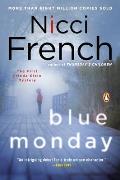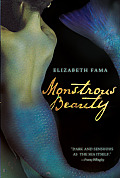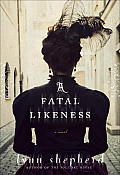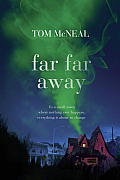
Recently I had a chance to check out
Artists in the Archives: A Collection of Card Catalogs at the
Greenburgh (NY) Public Library. There was a
New York Times article about the exhibit, but I first learned about it when
Artists in the Archives was featured on the
Library as Incubator blog (
post 1;
post 2).
The exhibit is on display from April through September 2013 on the second floor of the library's gorgeous new (as of 2009) green building. Here's how
Artists in the Archives is described on the library website:
More than 85 artists, poets, writers, musicians, librarians and creative thinkers have contributed to the collection of art contained in the drawers of library card catalogs on display on the library's second floor. (exhibits page)
The exhibit consists of three separate installations: "Book Marks" by Barbara Page, one artist, one card catalog; "The 'Alternet'" by Carla Rae Johnson, over 70 artists, one card catalog; and "The Call to Everyone" by JoAnne Wilcox, one card catalog for everyone. Artists in the Archives is a very friendly, hands-on exhibit -- notice how all the labels say "Browsing Welcome." I took lots of photos.
The exhibit had a that encouraged visitors to leave feedback. I was happy to oblige.
I'll start my overview of the exhibit with "
Book Marks," which was my least favorite of the three. "Book Marks" was the least interactive of the installations as it was fully contained within a glass exhibit case. The glass also made it difficult to photograph (the black and white pattern evidenced in the pair of close-ups is the shirt I was wearing reflected in the glass).
Rather than catalog cards, artist Barbara Page's project utilized book cards, the kind that lived in pockets in the back of
library books prior to the computerization of libraries. As you can see in the image above, the installation included a card file, but it lacks the rod used to tether catalog cards to the drawer.
I assume that the reason the installation encased precisely because her altered cards would be particularly easy to steal otherwise.
1 I liked looking at Page's work and seeing how the text on the individual cards inspired her art, but this installation was destined to play 3rd fiddle to the others simply because it disallowed participation while the others encouraged it.

When I arrived at the exhibit, "
The 'Alternet'" installation looked just as it is pictured on the left. Two the drawers had been left out on one of the cabinet's built-in trays, evidence of a previous visitor's interaction with the installation.
Each of the drawers of this large cabinet were labeled with individuals names (one or two to a drawer). Those labels indicate the artists whose work is contained within each drawer (50 drawers, 70 artists, including the organizer Carla Rae Johnson). The work within the card catalog as a whole is varied. Some cards are drawn or painted upon. Others have photographs or other printed material affixed to them. And others have been augmented by three-dimensional objects.
The image above shows three of the drawers open to a random location.
The drawers are not in any order in the cabinet and I have to admit that I had to resist the urge to arrange them all alphabetically by the authors' last names. Below are close-ups of a couple of cards that I especially liked. I stupidly did not take note of the artists and I can't even make out the name on the visible label (especially not without a full list of contributor names to work from).
2
There is a Facebook group for "
The 'Alternet'"(
link). I did try to suss out appropriate attribution by going through its many photo albums, but I didn't find an exact match and am not confident enough to even list a possible author for each of the cards. I am planning to visit the exhibit again and when I do, I will attempt to locate these two cards again and take note of their authorship.

When I first started exploring the exhibit, "
The Call to Everyone" installation seemed the least appealing to me. It consisted of a 25-drawer catalog card cabinet (drawers labeled traditionally) with a 4-drawer card file on top. There were also a few stamps and stamp pads scattered across their surfaces. The cabinet contained catalog cards, but most of them were not altered like the ones featured in "The 'Alternet'" installation. The card file contained loose, unaltered catalog cards.

Of course I hadn't bothered to read the installation's label before I started digging into the drawers. The label explained that "
The Call to Everyone" was the most participatory of the installations and encouraged visitors to select four cards (presumably from the card file), alter them with images taken with their cell phone cameras, and return them to the library for inclusion in the installation (presumably in the cabinet). It directed interested parties to
www.thecalltoeveryone.com, where further instructions would be available. The purpose of the stamps and stamp pads also became clear. You can see how I used one of them below.
I selected my four catalog cards (pictured below) and I have every intention of becoming a full participant in the installation. I already have specific ideas for appropriate images for two of the cards.
3 I chose the other two because I was confident that I'd be able to figure out something that'd go along with their content.
Expect another post when I've altered my cards and have returned them to the library.
- For what it's worth, ALL of the altered cards in the other installations could be stolen fairly easily and I'm not just saying this because my library still has a card catalog. Figuring out how to remove a drawer's rod is not rocket science.
- I didn't manage to snap an image of "The 'Alternet'"'s label, which did have the list of names, either.
- Russell groaned when I told him where I needed to go in order to take one of them so I may be in for a solo irritating traffic-filled excursion in the near future.

 At the public library I usually select books from the new acquisitions areas. Last time I was at my local branch looking for books I happened upon Nicci French's
At the public library I usually select books from the new acquisitions areas. Last time I was at my local branch looking for books I happened upon Nicci French's  Recently I had a chance to check out Artists in the Archives: A Collection of Card Catalogs at the
Recently I had a chance to check out Artists in the Archives: A Collection of Card Catalogs at the 



 When I arrived at the exhibit, "The 'Alternet'" installation looked just as it is pictured on the left. Two the drawers had been left out on one of the cabinet's built-in trays, evidence of a previous visitor's interaction with the installation.
When I arrived at the exhibit, "The 'Alternet'" installation looked just as it is pictured on the left. Two the drawers had been left out on one of the cabinet's built-in trays, evidence of a previous visitor's interaction with the installation.


 When I first started exploring the exhibit, "The Call to Everyone" installation seemed the least appealing to me. It consisted of a 25-drawer catalog card cabinet (drawers labeled traditionally) with a 4-drawer card file on top. There were also a few stamps and stamp pads scattered across their surfaces. The cabinet contained catalog cards, but most of them were not altered like the ones featured in "The 'Alternet'" installation. The card file contained loose, unaltered catalog cards.
When I first started exploring the exhibit, "The Call to Everyone" installation seemed the least appealing to me. It consisted of a 25-drawer catalog card cabinet (drawers labeled traditionally) with a 4-drawer card file on top. There were also a few stamps and stamp pads scattered across their surfaces. The cabinet contained catalog cards, but most of them were not altered like the ones featured in "The 'Alternet'" installation. The card file contained loose, unaltered catalog cards. Of course I hadn't bothered to read the installation's label before I started digging into the drawers. The label explained that "The Call to Everyone" was the most participatory of the installations and encouraged visitors to select four cards (presumably from the card file), alter them with images taken with their cell phone cameras, and return them to the library for inclusion in the installation (presumably in the cabinet). It directed interested parties to
Of course I hadn't bothered to read the installation's label before I started digging into the drawers. The label explained that "The Call to Everyone" was the most participatory of the installations and encouraged visitors to select four cards (presumably from the card file), alter them with images taken with their cell phone cameras, and return them to the library for inclusion in the installation (presumably in the cabinet). It directed interested parties to 
 Ever since writing was invented, people have been documenting the contents of their brains, giving names to ideas, noting their dreams, and distorting their memories and making up new ones. Lifetimes of scribbling, and oceans of ink. Whole forests of trees reduced to pulp for us to collect our words. What if nobody reads them? I think we write to be read, even if we tell ourselves we don't. But the vast majority of everything written fails in its most basic purpose and has never been read by another. Where are you to read my works, Tomomi Ishikawa? Are we talking to ourselves? (175)
Ever since writing was invented, people have been documenting the contents of their brains, giving names to ideas, noting their dreams, and distorting their memories and making up new ones. Lifetimes of scribbling, and oceans of ink. Whole forests of trees reduced to pulp for us to collect our words. What if nobody reads them? I think we write to be read, even if we tell ourselves we don't. But the vast majority of everything written fails in its most basic purpose and has never been read by another. Where are you to read my works, Tomomi Ishikawa? Are we talking to ourselves? (175) In the early 1870s in Plymouth, Massachusetts, a mermaid named Syrenka falls in love with a young naturalist and decides to give up her immortality for a life on land with him. In modern day Plymouth, 17-year-old Hester disdains love because generations of her female ancestors (including her own mother) have died shortly after the birth of their first child. It is only after Hester meets the magnetic Ezra that she realizes just how naive her romance-avoidance plan was. At the suggestion of Ezra, Hester begins to research her family history in the hope of determining the true cause of the postpartum deaths and whether there's a way she can avoid her own.
In the early 1870s in Plymouth, Massachusetts, a mermaid named Syrenka falls in love with a young naturalist and decides to give up her immortality for a life on land with him. In modern day Plymouth, 17-year-old Hester disdains love because generations of her female ancestors (including her own mother) have died shortly after the birth of their first child. It is only after Hester meets the magnetic Ezra that she realizes just how naive her romance-avoidance plan was. At the suggestion of Ezra, Hester begins to research her family history in the hope of determining the true cause of the postpartum deaths and whether there's a way she can avoid her own.
 While there is a disturbing scene early in
While there is a disturbing scene early in  In the third installment of her literary mystery series featuring thief-taker1 Charles Maddox,2 Shepherd seeks to fill the "inexplicable gaps and strange silences" (8) in the biographical record of the Young Romantics. The action of the novel begins when Charles Maddox is summoned to Sir Percy Shelley (son of Percy Bysshe and Mary) and asked to spy on someone claiming to have some of the famous poet's private papers for sale. The more Maddox learns about the assignment and his clients, the more complicated things begin to seem and the less altruistic their decision to employ him.
In the third installment of her literary mystery series featuring thief-taker1 Charles Maddox,2 Shepherd seeks to fill the "inexplicable gaps and strange silences" (8) in the biographical record of the Young Romantics. The action of the novel begins when Charles Maddox is summoned to Sir Percy Shelley (son of Percy Bysshe and Mary) and asked to spy on someone claiming to have some of the famous poet's private papers for sale. The more Maddox learns about the assignment and his clients, the more complicated things begin to seem and the less altruistic their decision to employ him.
 Jacob Grimm, the eldest of the famous Brothers Grimm, is a troubled soul caught in the Zwischenraum, the place between. After years attempting to discover and resolve "the thing undone" (that which is keeping him in limbo), Jacob learns from another ghost of an Exceptional, one of the few living souls who can hear ghosts speak, and a "Finder of Occasions who would bring harm to the boy" (48). Jacob determines to find the boy and to protect him from the Finder of Occasions.
Jacob Grimm, the eldest of the famous Brothers Grimm, is a troubled soul caught in the Zwischenraum, the place between. After years attempting to discover and resolve "the thing undone" (that which is keeping him in limbo), Jacob learns from another ghost of an Exceptional, one of the few living souls who can hear ghosts speak, and a "Finder of Occasions who would bring harm to the boy" (48). Jacob determines to find the boy and to protect him from the Finder of Occasions.